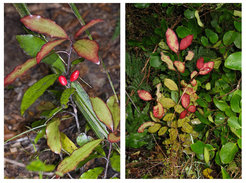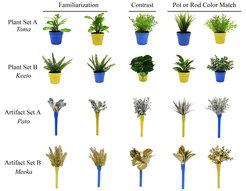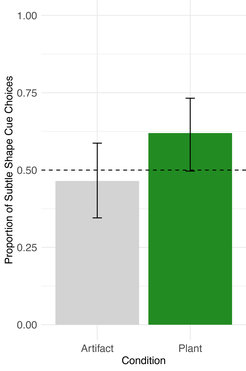Branching Out
Branching Out: Categorization in Infancy
Branching Out: Infant Visual Perception
The proposal that plants have had a role in shaping many aspects of human cognition means that our research agenda intersects with a variety of well-established research areas. Accordingly, our recent work has broken new ground within existing research traditions. One recently completed project, funded by a grant from the German Research Foundation (DFG), explores novel aspects of food learning in infancy by testing whether 12-month-olds view food processing actions (e.g., cutting a vegetable into pieces) as indicators of edibility. This project used eye-tracking measures, including pupil dilation, and concluded data collection in the summer of 2023. Another ongoing collaborative project with Dr. Andreas Wilke at Clarkson University, Potsdam, USA, funded by the National Science Foundation (NSF), is examining the impact of an evolutionary history of foraging for clumpy resources (e.g., fruits growing on a tree) on statistical reasoning in 3- to 10-year-old children. In this section, we outline two different projects that investigate novel lines of inquiry within object categorization and visual perception, respectively.
Branching Out: Categorization in Infancy
In this project, we examined a novel question within the categorization literature. Specifically, along with Stella Gerdemann, who is now a postdoctoral fellow in the Center for Lifespan Psychology (LIP), we tested whether 18-month-olds use different features to categorize plants than they do other object types (Gerdemann & Wertz, 2021). This article won the Human Behavior and Evolution Society’s Margo Wilson Award for the best paper published in the journal Evolution and Human Behavior in 2021.
There are good reasons to predict that categorization rules for plants might have specific design features. Many plants look similar to each other. In fact, some edible plants have evolved a strategy of mimicking poisonous plants in order to protect themselves from being eaten (Figure 1). As a result, the differences between distinct types of plants can be subtle.

Figure 1. Disguised to survive: The mountain alseuosmia (Alseuosmia Pusilla, left panel) has evolved leaves of similar shape, size, and coloration as the toxin-rich New Zealand pepperwood (Pseudowintera colorata, right panel), which helps it avoid herbivorous predators. This is an example of Batesian mimicry.
Left image: “Atiwhakatu Valley, Tararua Forest Park.” by Jeremy R. Rolfe on New Zealand Plant Conservatory Network, original image licensed under CC BY 4.0
Right image: “Pseudowintera colorata, Horopito, pepper tree (Plant, Winteraceae), New Zealand: Endemic” by Jon Sullivan on flickr, original image licensed under CC BY-NC 2.0
Mistaking a poisonous plant for an edible one can be a costly error. Therefore, it is essential for any successful plant forager to be able to tell them apart. In fact, our evolutionary modeling work indicates that strategies for successfully distinguishing between different kinds of plants are critical to successful social learning (Oña et al., 2019). Building on this prior modeling work, we set out to test whether generalization rules for plants would be based on fine-grained features that can distinguish similar-looking plants in a study with infants. This project was preregistered on OSF.
We used a variation of a classic task in cognitive development research—a name extension task—to test whether 18-month-olds (N = 40) rely on fine-grained features when categorizing plants, but not in other contexts. Our stimuli were realistic-looking artificial plants with various leaf shapes (Figure 2, top two rows) and feature-matched artifacts made from the exact same leaves as the plants, painted in different colors (Figure 2, bottom two rows).
Our name extension task (Figure 3) had two between-subjects conditions. In one condition, infants were told the name of one type of plant, and then presented with exemplars of that same type of plant and a different type of plant. Infants were asked to identify the plant with the same name as the first plant. In the other condition, infants were shown the same task with the feature-matched artifacts. Given the importance of fine-grained features for distinguishing between plants, our preregistered prediction was that infants would reliably choose the plant with the same leaf shape in the plant condition, but would choose equally between the artifacts in the artifact condition.


Figure 3. An overview of key phases of the procedure. The plant condition is shown here; the procedure was identical for the artifact condition. (A) Familiarization phase. Two familiarization objects are presented and named, and infants are given 15 seconds to explore them. (B) Contrast phase. Infants are presented with a contrast object that differs in fine-grained features from the familiarization objects and given 15 seconds to explore it. (C–E) Choice phase. The target is presented centrally in front of E and the two test objects are to her right (fine-grained feature match) and left (pot color match; the side of the test objects was counterbalanced across choice phases). Infants are reminded of the target object’s name and asked which one of the test objects goes with the target.

Figure 4. The proportion of 18-month-olds’ choices for the fine-grained feature match in the plant and artifact conditions. Infants’ choices for the fine-grained feature match were above chance (indicated by the dotted line) in the plant condition (V = 66.5, p = .032, 95% CI [0.54, 0.88]) and did not differ from chance in the artifact condition (V = 17, p = .32, 95% CI [0.29, 0.67]).
Images Figure 2, 3, and 4: Gerdemann & Wertz (2021), as provided by MPI for Human Development, original image licensed under CC BY-NC-ND 4.0; originally published by Elsevier in Evolution and Human Behavior
We found that, as predicted, infants chose the plant with the same fine-grained features (i.e., leaf type) at greater than chance levels in the plant condition, while the proportion of choices for the fine-grained feature match did not differ from chance in the artifact condition (Figure 4). A second study indicated that this difference persists to some degree into adulthood. These results indicate that infants prioritize fine-grained features like leaf shape when generalizing learned information about plants, and demonstrate that infants use different categorization rules for different types of entities.
In summary, this project highlights how theorizing about PLANT systems can uncover new aspects of existing research areas. Given the ubiquity and importance of plants across human evolution, it stands to reason that many aspects of categorization processes may reflect regularities in the botanical world. We look forward to expanding on these initial findings to explore plant categorization rules in detail in the future.
Branching Out: Infant Visual Perception
In this project, we used eye tracking to investigate how infants parse naturalistic scenes at the level of visual perception (Schlegelmilch & Wertz, 2022). Previous studies of infant visual perception mainly used single entities like objects, graphics, or faces presented on uniform backgrounds, but infants’ everyday visual environments are replete with complex overlapping forms (Figure 5, left panel). Our aim therefore was to explore visual properties that infants use to distinguish visually complex naturalistic structures. To do this, we tested 8-month-old infants (N = 39) and a comparison sample of adults (N = 20) using a gaze-contingent eye-tracking visual search task. Our stimuli were created from photographs showing extracts of the kinds of entities that appear in naturalistic human environments: vegetation, human-made artifacts, and non-living natural elements (Figure 5, right panel).

Figure 5. Examples of vegetation, artifacts, and non-living natural elements in a naturalistic visual environment (left panel) and example images from each category used in Schlegelmilch & Wertz, 2022 (right panel).
Left image: David Pietraszewski
Right image: adapted from Schlegelmilch & Wertz (2022)
Original image licensed under CC BY 4.0
Infants’ task in this study was to locate a small patch of target image embedded in a background image. If the eye-tracker registered the infant’s gaze on the target, it was counted as a “hit” and a visual reward was shown to the infant (Figure 6). We assessed whether or not the target was detected (a “hit” versus a “miss”) and the latency to detect the target. The target patch and background image differed along a number of dimensions related to specific visual properties (Figure 7A). The visual properties tested in this study were selected from the literature on visual perception and either computationally assessed directly from the images or rated by adults.

Left image: MPI for Human Development
Right image: adapted from Schlegelmilch & Wertz (2022)
Original image licensed under CC BY 4.0
We did not find evidence that infants performed better with any specific type of naturalistic entity in this task. For example, there was no effect of image category (vegetation, artifact, and non-living natural element) on how quickly infants detected the target image. Instead, we discovered several visual properties that predicted infants’ detection success (Figure 7B). The properties “deviation” and “depth,” for example, strongly affected infants’ search performance. “Deviation” refers to variations in spatial frequency distributions indicating scaling invariance (i.e., a fractal-like quality), and greater differences in deviation between the target and background images were associated with higher probabilities that infants detected the target. “Depth” refers to the spatial arrangement of scene elements, and higher values of depth in the background image were associated with longer detection latencies. These findings are particularly interesting because these properties also impacted categorization decisions in preschool-aged children and in adults in a separate study using these same images (Schlegelmilch & Wertz, 2023). We also found clear developmental differences for a number of properties. For example, the property “alpha” refers to the proportion of larger to smaller changes between light and dark image regions. This property reliably distinguishes between the different stimulus categories of vegetation, artifact, and non-living natural element, but it only predicted adults’ detection performance in this study.

Adapted from Schlegelmilch & Wertz (2022)
Original image licensed under CC BY 4.0
Taken together, these findings bring new insights to research on the development of image segmentation and visual search. First, we found that 8-month-old infants were able to parse visually complex naturalistic images. Second, we found that properties such as variations in spatial frequency distributions of the images indicating scaling invariance (i.e., the property “deviation”) predicted detection success as well as low-level salience (i.e., target–background differences in luminance). These findings show that, although the superordinate categories vegetation, artifact, and non-living natural elements did not predict detection performance in our search task, infants are sensitive to visual properties that vary in visually complex naturalistic scenes. In the future, we hope to investigate whether social information about plants and other entities in naturalistic scenes impacts infants’ visual search. Thus, at a broader level, this project demonstrates the benefits of investigating the early development of visual perception with naturalistic stimuli that reflect real-world human environments.
Key References



![Figure 4. The proportion of 18-month-olds’ choices for the fine-grained feature match in the plant and artifact conditions. Infants’ choices for the fine-grained feature match were above chance (indicated by the dotted line) in the plant condition (V = 66.5, p = .032, 95% CI [0.54, 0.88]) and did not differ from chance in the artifact condition (V = 17, p = .32, 95% CI [0.29, 0.67]). The proportion of 18-month-olds’ choices for the fine-grained feature match in the plant and artifact conditions](/101078/original-1689835834.jpg?t=eyJ3aWR0aCI6MzQxLCJmaWxlX2V4dGVuc2lvbiI6ImpwZyIsIm9ial9pZCI6MTAxMDc4fQ%3D%3D--9accc8983810428b5ced51892d903fd2ad7a33a3)


